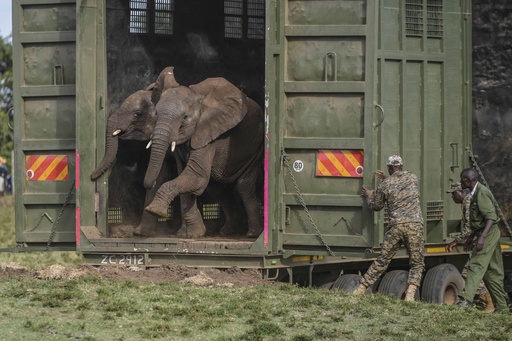
MWEA, Kenya — In a significant wildlife management effort, a helicopter maintained its position above a tranquilized elephant while a skilled veterinarian prepared to administer a tranquilizer dart. The dart flew through the air, and soon after, the enormous creature succumbed to a deep sleep, allowing wildlife experts to quickly assess its condition.
Kenya is currently grappling with an issue, but one that highlights positive outcomes. The elephant population within the 42-square-kilometer (16-square-mile) Mwea National Reserve, located east of Nairobi, has surged from a maximum of 50 to an impressive 156. This growth is straining the ecosystem and has made it necessary to relocate approximately 100 of these majestic animals. The reserve was home to just 49 elephants back in 1979.
Director General Erustus Kanga of the Kenya Wildlife Service noted that the overpopulation situation in Mwea is indicative of the successful conservation endeavors over the past 30 years. “This demonstrates that poaching levels have decreased, allowing the elephants to prosper,” Kanga commented.
Last week, experts initiated the relocation of 50 elephants to the expansive Aberdare National Park, which spans 780 square kilometers (301 square miles) in central Kenya. By Monday, 44 elephants had successfully made the journey from Mwea to Aberdare, with six more scheduled for relocation the following day.
Tourism Minister Rebecca Miano was present to oversee the relocation of five elephants on Monday, stating, “This will be remembered as a landmark event, being the largest operation of its kind. For the first time, we are witnessing the translocation of 50 elephants in one go.”
The operation commenced at dawn and involved a coordination of over 100 wildlife professionals, utilizing a range of equipment—including specialized trucks, aircraft, and vehicles. A fixed-wing plane conducted aerial surveys to locate herds of elephants, which typically move in small family groups of about five. This aircraft maintained constant communication with two helicopters, which were deployed to guide and separate the elephants, ensuring that family units remained together during relocation.
Inside one helicopter, a spotter searched for the elephants alongside a veterinarian armed with a tranquilizer gun. After an elephant was sedated, a ground team comprising veterinary specialists and rangers swiftly moved in to prepare the animal for transport. They monitored its vitals while additional rangers worked on carefully hoisting the large animal weighing several hundred kilograms onto specialized trucks, set to travel 120 kilometers (74 miles) to its new habitat.
Kanga emphasized that this relocation effort also aimed to mitigate human-wildlife conflicts. Local resident Boniface Mbau expressed relief: “We are very pleased that the government has taken steps to reduce the number of elephants in our area. Their increased numbers led to food shortages in the reserve, prompting them to invade our farms.”
A follow-up phase is planned to move an additional 50 elephants, although the timeline for this has yet to be announced. The wildlife agency indicated that the entire project has been funded with at least 12 million Kenyan shillings (approximately $93,000).
Kenya’s national parks and reserves are vibrant ecosystems that support a wide array of wildlife species and attract millions of tourists each year, solidifying the country’s reputation as a premier travel destination.
